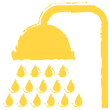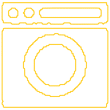
Between 2010 and 2019, water consumption in France will be distributed as follows:
58% for agriculture
26% for drinking water production
12% for the energy sector (cooling of power stations)
4% for industry (tourism and food processing in particular)
Of the water we consume at home, 39% is used for washing and 20% for the toilet.
148 litres is the average consumption of drinking water in France per person per day
As part of our voluntary commitment to protecting the environment, we pay close attention to the use of water, and we encourage you to be equally vigilant. Here are a few ways in which you too can take concrete action and have fun at the same time! We currently use between 67 and 71 litres of water per night on the campsite, with a target of under 50 litres per night. Let’s share our good ideas and encourage each other to go further.

To help you keep time under control in the shower, we’ve installed hourglasses ⏳.
The 2024 challenge: your mission, if you accept it, will be to respect the maximum showering time of 3 minutes. If you succeed, you can symbolically make your success visible to our community of campers.

Thanks to the rainwater recovery tank that will supply the toilets in the washrooms, we’re going to avoid using drinking water for the toilets. However, in summer, it doesn’t rain very often and the tank won’t be enough to manage the flushes for the whole season.
The 2024 challenge: your mission, if you accept it, will be to use the dual 3l/6l function and to accompany your children to explain this rule to them.

The third item is the washing machine, which accounts for 12% of water consumption in the home.
The 2024 challenge: your mission, if you accept it, will be to fill the washing machine properly rather than running it half full. A tip to help you in your mission: ask your neighbours to top up the machine if you don’t have enough clothes to wash.
The data presented here comes from ADEME, the French Environment and Energy Management Agency, May 2023
The main action is to hunt for leaks, because losses can go very, very quickly! That’s why we take meter readings every day. As a result, we have detected micro-leaks in many circuits, which we have been able to eradicate.
The taps are fitted with aerators with flow reducers adapted to their use.
The bathroom sinks are at 1.7l/min, which is enough for hand washing, for example. This action can be reinforced by using a glass to rinse after brushing your teeth.
Kitchen sinks require a little more flow and are rated at 6l/min. To wash your dishes, use the tray or a basin and don’t let the water run.
Showers use 6l/min. The eco-gesture is to turn off the water when soaping up, 30 seconds of stopping is 3l of water saved!
The water points have been changed to timed push-buttons with flow limiters. Don’t let your children play with the water from these hydrants, the boats must stay in the pool and not in the paths!
Installation of a washing machine in the kitchen with a water-saving dishwasher.
Rainwater collection and drip irrigation system. This complements the permaculture work and the choice of endemic plants, which consume less water.
Let’s play!
Mr Orassion has bought a flow reducer for his shower head from the village DIY shop. On his way home, he asks his daughter Amélie to help him calculate the amount of water the family will save over the year.
Knowing that the current shower flow rate is 15l/min, that Amélie, her dad, her mum and her brother Maximin take 1 shower a day for 5 minutes, and that the new flow rate is 6l/min.
1/ Approximately how much will Amélie Orassion save?
5m3
25m3
65m3
120m3
2/ Nicole, Amélie’s mum, challenges her daughter a little more and asks her how much more water the Orassion family would save if they stopped running the water for the 30 seconds they were soaping up?
0.5m3
1.5m3
4.5m3
10m3
Game solutions : 1/ 65m3 2/ 4.5m3